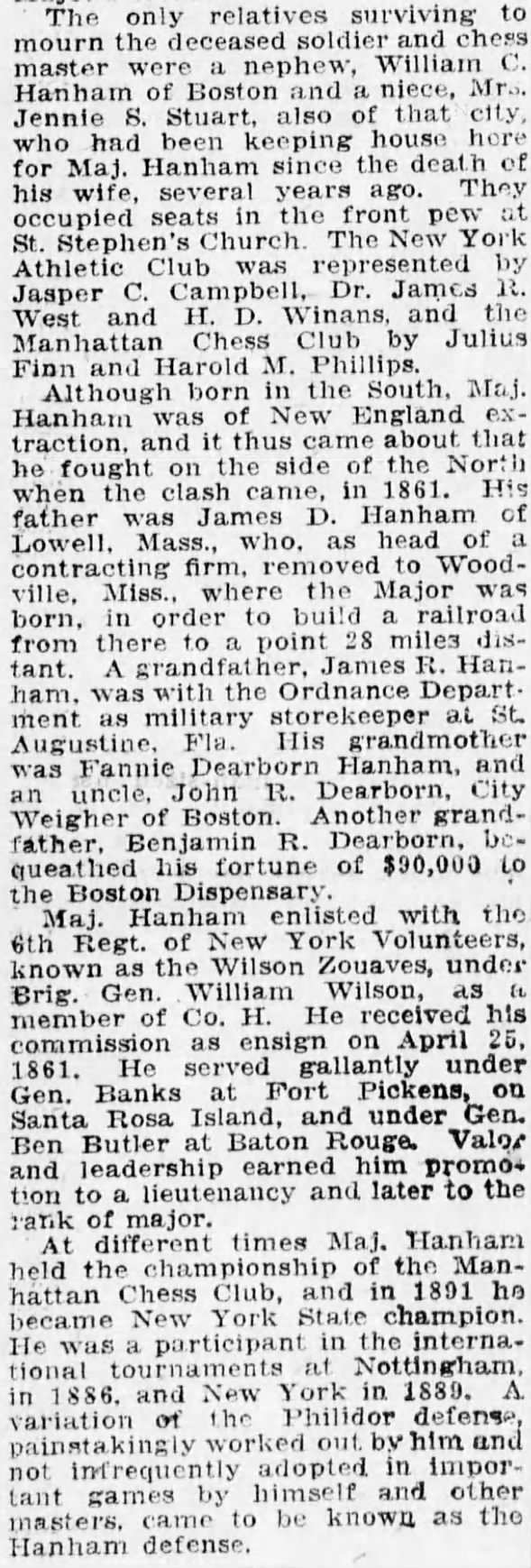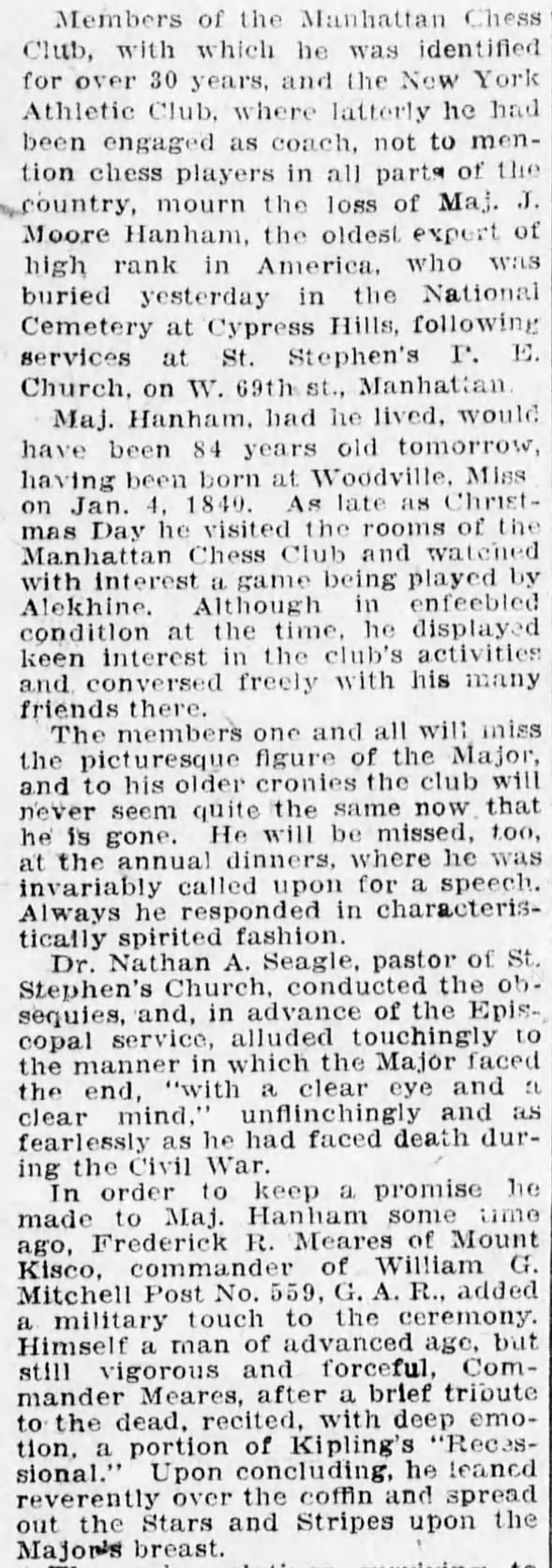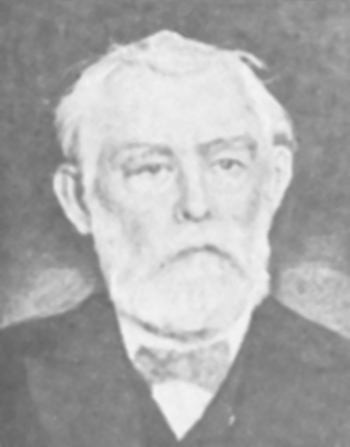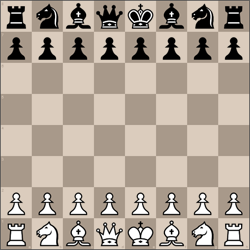Additional Games
 Hanham Simultaneous Exhibition 13 Feb 1893, Mon The Standard Union (Brooklyn, New York) Newspapers.com
Hanham Simultaneous Exhibition 13 Feb 1893, Mon The Standard Union (Brooklyn, New York) Newspapers.com
Major J. Moore Hanham, the veteran chess expert, entertained the members of the Brooklyn C. C. with an exhibition of simultaneous playing last Saturday evening, at the club rooms, 201 Montague street. Major Hanham has made a great record in the local chess world in past years, few events having occurred in which he has not taken a prominent part as a player. He was a competitor in the Sixth American Chess Congress, held in New York in 1889, and defeated some of the strongest players of that tournament. He has been champion of the New York State Chess Association and won the “Staats-Zeitung” Cup for the Manhattan C. C, at the meeting of the association in 1891; he was only a half game behind Emil Kemeny in the same event last year. Mr. Hanham tied for third prize in the Brooklyn C. C. championship tournament of last year with A. E. Blackmar and A. B. Hodges. The Major was in excellent form Saturday evening, playing rapidly, and finished the twelve games in less than three hours; he won ten games, lost one to W. W. Thayer, and drew a game with Daniel Ottolengui. Following is the team, with openings and results:
Following is Mr. Ottolengui's game, which he good-naturedly called a draw, though he had a winning position:
Major James Moore Hanham (white) vs. Daniel Ottolengui (black)
French Defense: Advance Variation, Paulsen Attack

 Manhattan CC Club Pays Respects 03 Jan 1924, Thu The Brooklyn Daily Eagle (Brooklyn, New York) Newspapers.com
Manhattan CC Club Pays Respects 03 Jan 1924, Thu The Brooklyn Daily Eagle (Brooklyn, New York) Newspapers.com
 Members of the Manhattan Chess Club, with which he was identified for over 30 years, and the New York Athletic Club, where latterly he had been engaged as coach, not to mention chess players in all part of the country, mourn the loss of Maj. J. Moore Hanham, the oldest expert of high rank in America, who was buried yesterday in the National Cemetery at Cypress Hills, following services at St. Stephen's P. E. Church, on W. 69th St., Manhattan.
Members of the Manhattan Chess Club, with which he was identified for over 30 years, and the New York Athletic Club, where latterly he had been engaged as coach, not to mention chess players in all part of the country, mourn the loss of Maj. J. Moore Hanham, the oldest expert of high rank in America, who was buried yesterday in the National Cemetery at Cypress Hills, following services at St. Stephen's P. E. Church, on W. 69th St., Manhattan.Maj. Hanham, had he lived, would have been 84 years old tomorrow, having been born at Woodville, Miss on Jan. 4, 1840. As late us Christmas Day he visited the rooms of the Manhattan Chess Club and watched with interest a game being played by Alekhine. Although in enfeebled condition at the time, he displayed keen interest in the club's activities and conversed freely with his many friends there.
The members one and all will miss the picturesque figure of the Major and to his older cronies the club will never seem quite the same now that he is gone. He will be missed, too, at the annual dinners, where he was invariably called upon for a speech. Always he responded in characteristically spirited fashion.
Dr. Nathan A. Seagle, pastor of St. Stephen's Church, conducted the obsequies, and, in advance or the Episcopal service, alluded touchingly to the manner in which the Major faced the end, “with a clear eye and a clear mind,” unflinchingly and as fearlessly as he had faced death during the Civil War.
In order to keep a promise he made to Maj. Hanham some time ago, Frederick K. Meares of Mount Kisco, commander of William G. Mitchell Post No. 559, G. A. R., added a military touch to the ceremony. Himself a man of advanced age, but still vigorous and forceful, Commander Meares, after a brief tribute to the dead, recited, with deep emotion, a portion of Kipling's “Recessional.” Upon concluding, he leaned reverently over the coffin and spread out the Stars and Stripes upon the Major's breast.
The only relatives surviving to mourn the deceased soldier and chess master were a nephew, William C. Hanham of Boston and a niece, Mrs. Jennie S. Stuart, also of that city, who had been keeping house here for Maj. Hanham since the death of his wife, several years ago. They occupied seats in the front pew at St. Stephen's Church. The New York Athletic Club was represented by Jasper C. Campbell, Dr. James R. West and H. D. Winans, and the Manhattan Chess Club by Julius Finn and Harold M. Phillips.
Although born in the South, Maj. Hanham was of New England extraction, and it thus came about that he fought on the side of the North when the clash came, in 1861. His father was James D. Hanham of Lowell, Mass., who, as head of a contracting firm, removed to Woodville. Miss., where the Major was born, in order to build a railroad from there to a point 28 miles distant. A grandfather, James R. Hanham, was with the Ordnance Department, as military storekeeper at St. Augustine, Fla. His grandmother was Fannie Dearborn Hanham, and an uncle, John R. Dearborn, City Weigher of Boston. Another grandfather, Benjamin R. Dearborn, bequeathed his fortune of, $90,000 to the Boston Dispensary.
Maj. Hanham enlisted with tho 6th Regt. of New York Volunteers, known as the Wilson Zouaves, under Brig. Gen. William Wilson, as a member of Co. H. He received his commission as ensign on April 25, 1861. He served gallantly under Gen. Banks at Fort Pickens, on Santa Rosa Island, and under Gen Ben Butler at Baton Rouge. Valor and leadership earned him promotion to a lieutenancy and later to the rank of major.
At different times Maj. Hanham held the championship of the Manhattan Chess Club, and in 1891 he became New York State champion. He was a participant in the international tournaments at Nottingham, in 1886, and New York in 1889. A variation of the Philidor defense painstakingly worked out by him and not infrequently adopted in important games by himself and other masters, came to be known as the Hanham defense.
























